

Sodium Batteries. Nickle Based Batteries. Lithium Batteries. Rechargeable battery. A common consumer battery charger for rechargeable AA and AAA batteries Rechargeable batteries typically initially cost more than disposable batteries, but have a much lower total cost of ownership and environmental impact, as they can be recharged inexpensively many times before they need replacing.
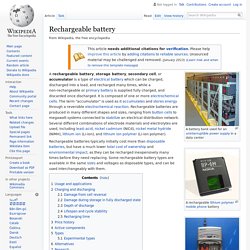
Some rechargeable battery types are available in the same sizes and voltages as disposable types, and can be used interchangeably with them. Usage and applications[edit] Devices which use rechargeable batteries include automobile starters, portable consumer devices, light vehicles (such as motorized wheelchairs, golf carts, electric bicycles, and electric forklifts), tools, uninterruptible power supplies, and battery storage power stations. Emerging applications in hybrid internal combustion-battery and electric vehicles drive the technology to reduce cost, weight, and size, and increase lifetime.[1] Rechargeable battery.
Lead acid (Types of Batteries) Flow Battery. UltraBattery. UltraBattery is a hybrid energy storage device invented by Australia’s Commonwealth Scientific and Industrial Research Organisation (CSIRO).

UltraBattery combines ultracapacitor technology with lead-acid battery technology in a single cell with a common electrolyte. Introduction[edit] Research conducted by independent laboratories, such as the United States's Sandia National Laboratories,[1] the Advanced Lead-Acid Battery Consortium (ALABC),[2] the Commonwealth Scientific and Industrial Research Organisation (CSIRO)[3] and commercial tests by East Penn Manufacturing, Furukawa Battery and Ecoult indicate that in comparison with conventional valve regulated lead acid (VRLA) batteries, UltraBattery technology has higher energy efficiencies, a longer lifetime and superior charge acceptance under partial state of charge (SoC) conditions.
History[edit] UltraBattery was invented in Australia by CSIRO.[7] The development of UltraBattery was funded by the Australian government. Hard Sulfation[edit] Super-iron battery. See also[edit] References[edit] Jump up ^ Licht, S.; R.
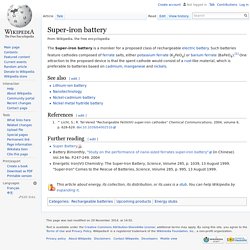
Tel-Vered "Rechargeable Fe(III/VI) super-iron cathodes" Chemical Communications, 2004, volume 6, p. 628-629. doi:10.1039/b400251b Further reading[edit] Sugar battery. A sugar battery is an enzymatic biofuel cell type rechargeable battery that is sugar-based.
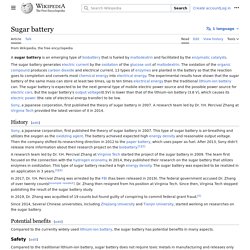
In 2014, researchers at Virginia Tech developed a battery that is run on sugar and closely competes with lithium-ions. They have an energy storage of 596 Ah kg−1, which is more than lithium-ions. If these batteries are proven, they could be used as soon as three years from now.[1] These batteries can be used to power a cell phone for ten days, unlike the current li-ions that can only be used for one day.[2] These biobatteries are cheaper to make, refillable, environmentally friendly and nonflammable.[3] Silver calcium battery. Silver Calcium alloy batteries are a type of lead-acid battery with grids made from lead-calcium-silver alloy, instead of the traditional lead-antimony alloy or newer lead-calcium alloy.
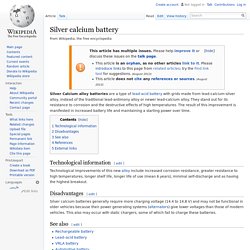
They stand out for its resistance to corrosion and the destructive effects of high temperatures. The result of this improvement is manifested in increased battery life and maintaining a starting power over time. Technological information[edit] Technological improvements of this new alloy include increased corrosion resistance, greater resistance to high temperatures, longer shelf life, longer life of use (mean 6 years), minimal self-discharge and as having the highest breakout.
Silver-oxide battery. A silver-oxide battery (IEC code: S) is a primary cell with a very high energy/weight ratio.

Available either in small sizes as button cells (where the amount of silver used is minimal and not a significant contributor to the product cost), or in large custom designed batteries where the superior performance of the silver-oxide chemistry outweighs cost considerations. These larger cells are mostly found in applications for the military, for example in Mark 37 torpedoes or on Alfa-class submarines. In recent years they have become important as reserve batteries for manned and unmanned spacecraft. Spent batteries can be processed to recover their silver content.
Silicon–air battery. Silicon–air batteries are created from oxygen and silicon.
Rechargeable fuel battery. Rechargeable fuel batteries are a new type of rechargeable battery that researchers have developed which uses electrodes in liquid form.
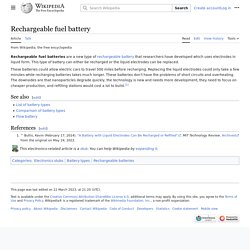
This type of battery can either be recharged or the liquid electrodes can be replaced. These batteries could allow electric cars to travel 500 miles before recharging. Replacing the liquid electrodes could only take a few minutes while recharging batteries takes much longer. These batteries don't have the problems of short circuits and overheating. The downsides are that nanoparticles degrade quickly, the technology is new and needs more development, they need to focus on cheaper production, and refilling stations would cost a lot to build.[1] Rechargeable alkaline battery. Rechargeable Alkaline AA battery A rechargeable alkaline battery (also known as alkaline rechargeable or rechargeable alkaline manganese (RAM)) is a type of alkaline battery that is capable of recharging for repeated use.

The first-generation rechargeable alkaline technology was developed by Battery Technologies Inc in Canada and licensed to Pure Energy, EnviroCell, Rayovac, and Grandcell. Subsequent patent and advancements in technology have been introduced. The formats include AAA, AA, C, D, and snap-on 9-volt batteries. Potassium-ion battery. The potassium battery has certain advantages in comparison with similar lithium batteries (e.g., lithium-ion batteries): the cell design is simple, and both the material used and the procedure needed for the cell fabrication are cheaper.

The prototype was made of KBF 4 electrolyte though almost all common electrolyte salts of lithium batteries (their potassium salts) can be used for the construction of potassium battery. The chemical diffusion coefficient of K+ in the cell is higher than that of Li+ in lithium batteries, which is due to a smaller Stokes radius of K+ in electrolyte solution (solvated ions). Since the electrochemical potential of K+ is identical to that of Li+, the cell potential is similar to that of lithium-ion.
Potassium batteries can accept a wide range of cathode materials with excellent rechargeability, cheaper materials, etc. The low cost of potassium in comparison with lithium has highlighted the idea of potassium battery in other forms too. Polysulfide bromide battery. The polysulfide bromide battery (PSB), (sometimes polysulphide bromide)), is a type of regenerative fuel cell involving a reversible electrochemical reaction between two salt-solution electrolytes: sodium bromide and sodium polysulfide.
It is an example and type of redox (reduction–oxidation) flow battery. In 2002, a 12 MWe prototype electrical storage facility was built at Little Barford Power Station in the UK, which uses polysulfide bromide flow batteries. Although the facility was completed, due to engineering issues in scaling up the technology, it was never fully commissioned.[1] A similar demonstration plant located at the Tennessee Valley Authority (TVA) facility in Columbus, Mississippi, United States was never completed. Chemistry[edit] Two different salt solution electrolytes are contained in two separate tanks. 2Na2S2 → Na2S4 + 2Na+ + 2e− At the positive electrode, the cathodic reaction is shown as: NaBr3 + 2Na+ + 2e−→ 3NaBr.
Polymer-based battery. Organic polymers can be processed at relatively low temperatures, lowering costs. They also produce less carbon dioxide.[2] History[edit] Organic batteries are an alternative to the metal reaction battery technologies, and much research is taking place in this area. Waseda University was approached by NEC in 2001, and began to focus on the organic batteries. In 2002, NEC researcher presented a paper on Piperidinoxyl Polymer technology, and by 2005 they presented an organic radical battery (ORB) based on a modified PTMA, poly(2,2,6,6-tetramethylpiperidinyloxy-4-yl meth-acrylate).[3] In 2006, Brown University announced a technology based on polypyrrole.[1][4] In 2007, Waseda announced a new ORB technology based on "soluble polymer, polynorborene with pendant nitroxide radical groups.
" In 2015 researchers developed an efficient, conductive, electron-transporting polymer. References[edit] External links[edit] Organic radical battery. An organic radical battery (ORB) is a relatively new type of battery first developed in 2005.[1] This type of battery is generally not available for the consumer, however their development is approaching practical use.[2] ORBs are potentially more environmentally friendly than conventional metal-based batteries, because they use organic radical polymers, which are flexible plastics, instead of metals to provide electrical power. ORBs are considered to be a high-power alternative to the Li-ion battery. Functional prototypes of the battery have been researched and developed by different research groups and corporations including the Japanese corporation NEC.[1] Current ORB research is being directed mostly towards Hybrid ORB/Li-ion batteries because organic radical polymers with appropriate electrical properties for the anode are difficult to synthesize.[3]
Fuel cell. Demonstration model of a direct-methanol fuel cell. The actual fuel cell stack is the layered cube shape in the center of the image Scheme of a proton-conducting fuel cell The first fuel cells were invented in 1838. The first commercial use of fuel cells came more than a century later in NASA space programs to generate power for satellites and space capsules. Since then, fuel cells have been used in many other applications. There are many types of fuel cells, but they all consist of an anode, a cathode, and an electrolyte that allows positively charged hydrogen ions (protons) to move between the two sides of the fuel cell.
The fuel cell market is growing, and in 2013 Pike Research estimated that the stationary fuel cell market will reach 50 GW by 2020.[3]